wheel alignment HYUNDAI I40 2019 Owners Manual
[x] Cancel search | Manufacturer: HYUNDAI, Model Year: 2019, Model line: I40, Model: HYUNDAI I40 2019Pages: 534, PDF Size: 11.05 MB
Page 170 of 534
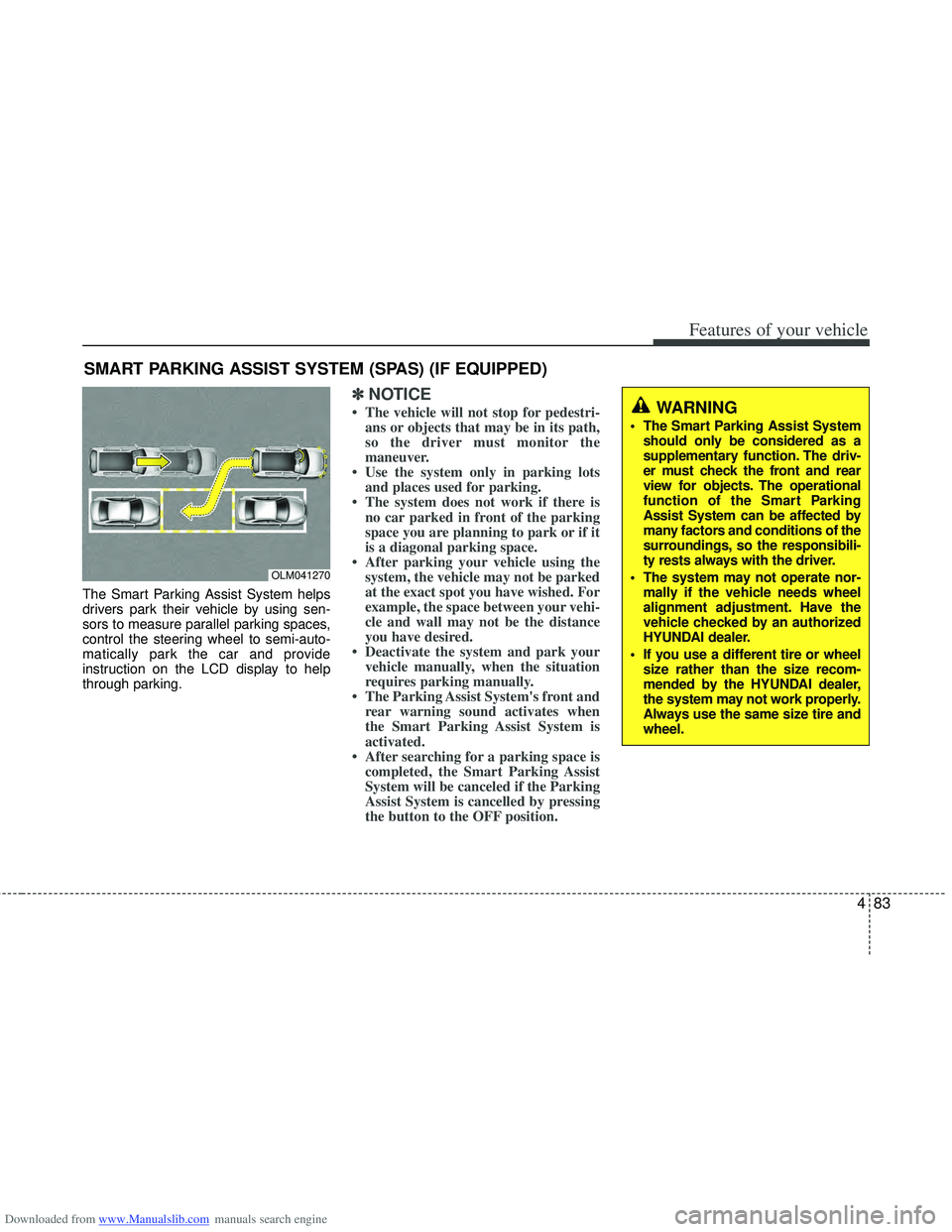
Downloaded from www.Manualslib.com manuals search engine 483
Features of your vehicle
The Smart Parking Assist System helps
drivers park their vehicle by using sen-
sors to measure parallel parking spaces,
control the steering wheel to semi-auto-
matically park the car and provide
instruction on the LCD display to help
through parking.
✽ ✽NOTICE
• The vehicle will not stop for pedestri-
ans or objects that may be in its path,
so the driver must monitor the
maneuver.
• Use the system only in parking lots and places used for parking.
• The system does not work if there is no car parked in front of the parking
space you are planning to park or if it
is a diagonal parking space.
• After parking your vehicle using the system, the vehicle may not be parked
at the exact spot you have wished. For
example, the space between your vehi-
cle and wall may not be the distance
you have desired.
• Deactivate the system and park your vehicle manually, when the situation
requires parking manually.
• The Parking Assist System's front and rear warning sound activates when
the Smart Parking Assist System is
activated.
• After searching for a parking space is completed, the Smart Parking Assist
System will be canceled if the Parking
Assist System is cancelled by pressing
the button to the OFF position.
SMART PARKING ASSIST SYSTEM (SPAS) (IF EQUIPPED)
OLM041270
WARNING
The Smart Parking Assist System
should only be considered as a
supplementary function. The driv-
er must check the front and rear
view for objects. The operational
function of the Smart Parking
Assist System can be affected by
many factors and conditions of the
surroundings, so the responsibili-
ty rests always with the driver.
The system may not operate nor- mally if the vehicle needs wheel
alignment adjustment. Have the
vehicle checked by an authorized
HYUNDAI dealer.
If you use a different tire or wheel size rather than the size recom-
mended by the HYUNDAI dealer,
the system may not work properly.
Always use the same size tire and
wheel.
Page 171 of 534
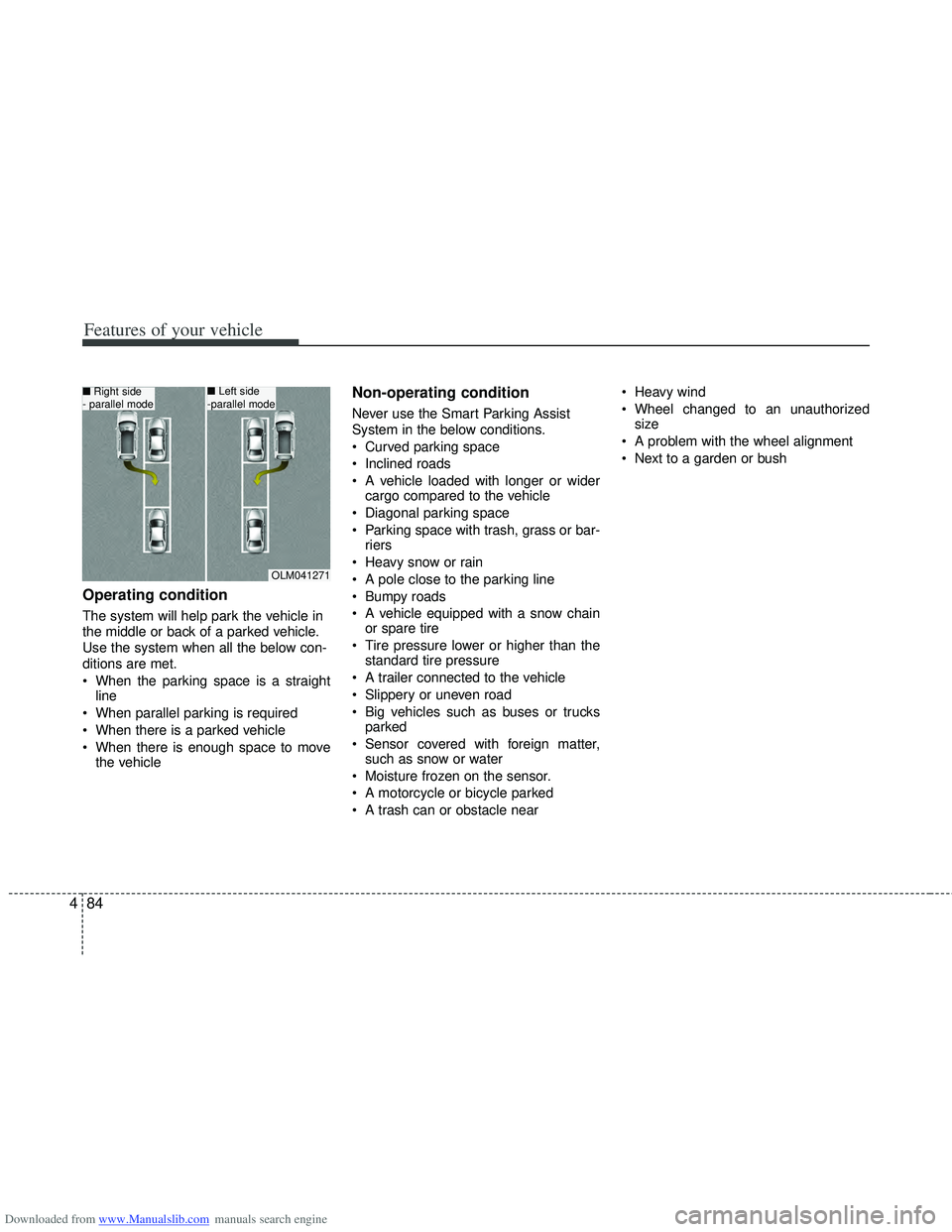
Downloaded from www.Manualslib.com manuals search engine Features of your vehicle
84
4
Operating condition
The system will help park the vehicle in
the middle or back of a parked vehicle.
Use the system when all the below con-
ditions are met.
When the parking space is a straight
line
When parallel parking is required
When there is a parked vehicle
When there is enough space to move the vehicle
Non-operating condition
Never use the Smart Parking Assist
System in the below conditions.
Curved parking space
Inclined roads
A vehicle loaded with longer or widercargo compared to the vehicle
Diagonal parking space
Parking space with trash, grass or bar- riers
Heavy snow or rain
A pole close to the parking line
Bumpy roads
A vehicle equipped with a snow chain or spare tire
Tire pressure lower or higher than the standard tire pressure
A trailer connected to the vehicle
Slippery or uneven road
Big vehicles such as buses or trucks parked
Sensor covered with foreign matter, such as snow or water
Moisture frozen on the sensor.
A motorcycle or bicycle parked
A trash can or obstacle near Heavy wind
Wheel changed to an unauthorized
size
A problem with the wheel alignment
Next to a garden or bush
OLM041271
■ Right side
- parallel mode■ Left side
-parallel mode
Page 356 of 534
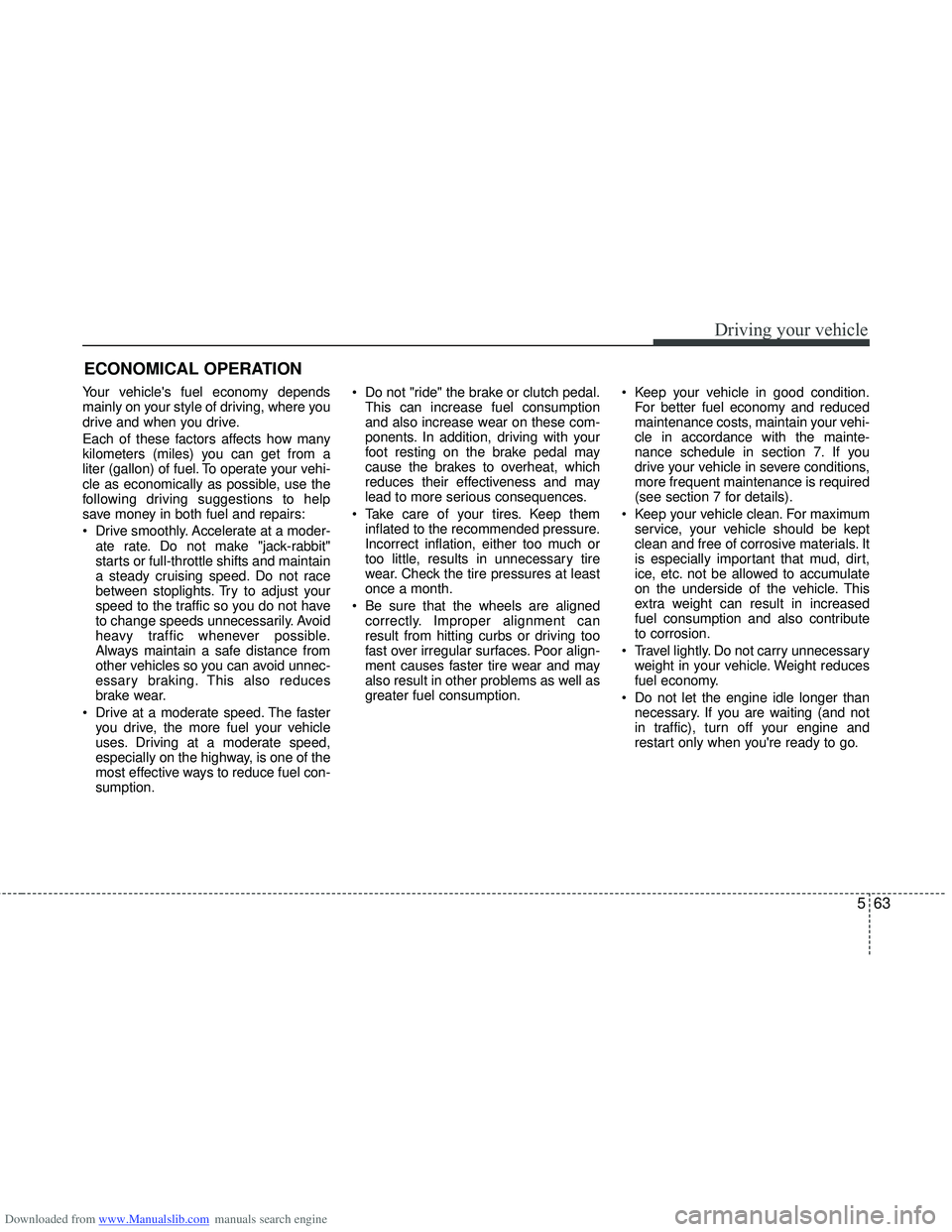
Downloaded from www.Manualslib.com manuals search engine 563
Driving your vehicle
ECONOMICAL OPERATION
Your vehicle's fuel economy depends
mainly on your style of driving, where you
drive and when you drive.
Each of these factors affects how many
kilometers (miles) you can get from a
liter (gallon) of fuel. To operate your vehi-
cle as economically as possible, use the
following driving suggestions to help
save money in both fuel and repairs:
Drive smoothly. Accelerate at a moder-ate rate. Do not make "jack-rabbit"
starts or full-throttle shifts and maintain
a steady cruising speed. Do not race
between stoplights. Try to adjust your
speed to the traffic so you do not have
to change speeds unnecessarily. Avoid
heavy traffic whenever possible.
Always maintain a safe distance from
other vehicles so you can avoid unnec-
essary braking. This also reduces
brake wear.
Drive at a moderate speed. The faster you drive, the more fuel your vehicle
uses. Driving at a moderate speed,
especially on the highway, is one of the
most effective ways to reduce fuel con-
sumption. Do not "ride" the brake or clutch pedal.
This can increase fuel consumption
and also increase wear on these com-
ponents. In addition, driving with your
foot resting on the brake pedal may
cause the brakes to overheat, which
reduces their effectiveness and may
lead to more serious consequences.
Take care of your tires. Keep them inflated to the recommended pressure.
Incorrect inflation, either too much or
too little, results in unnecessary tire
wear. Check the tire pressures at least
once a month.
Be sure that the wheels are aligned correctly. Improper alignment can
result from hitting curbs or driving too
fast over irregular surfaces. Poor align-
ment causes faster tire wear and may
also result in other problems as well as
greater fuel consumption. Keep your vehicle in good condition.
For better fuel economy and reduced
maintenance costs, maintain your vehi-
cle in accordance with the mainte-
nance schedule in section 7. If you
drive your vehicle in severe conditions,
more frequent maintenance is required
(see section 7 for details).
Keep your vehicle clean. For maximum service, your vehicle should be kept
clean and free of corrosive materials. It
is especially important that mud, dirt,
ice, etc. not be allowed to accumulate
on the underside of the vehicle. This
extra weight can result in increased
fuel consumption and also contribute
to corrosion.
Travel lightly. Do not carry unnecessary weight in your vehicle. Weight reduces
fuel economy.
Do not let the engine idle longer than necessary. If you are waiting (and not
in traffic), turn off your engine and
restart only when you're ready to go.
Page 413 of 534
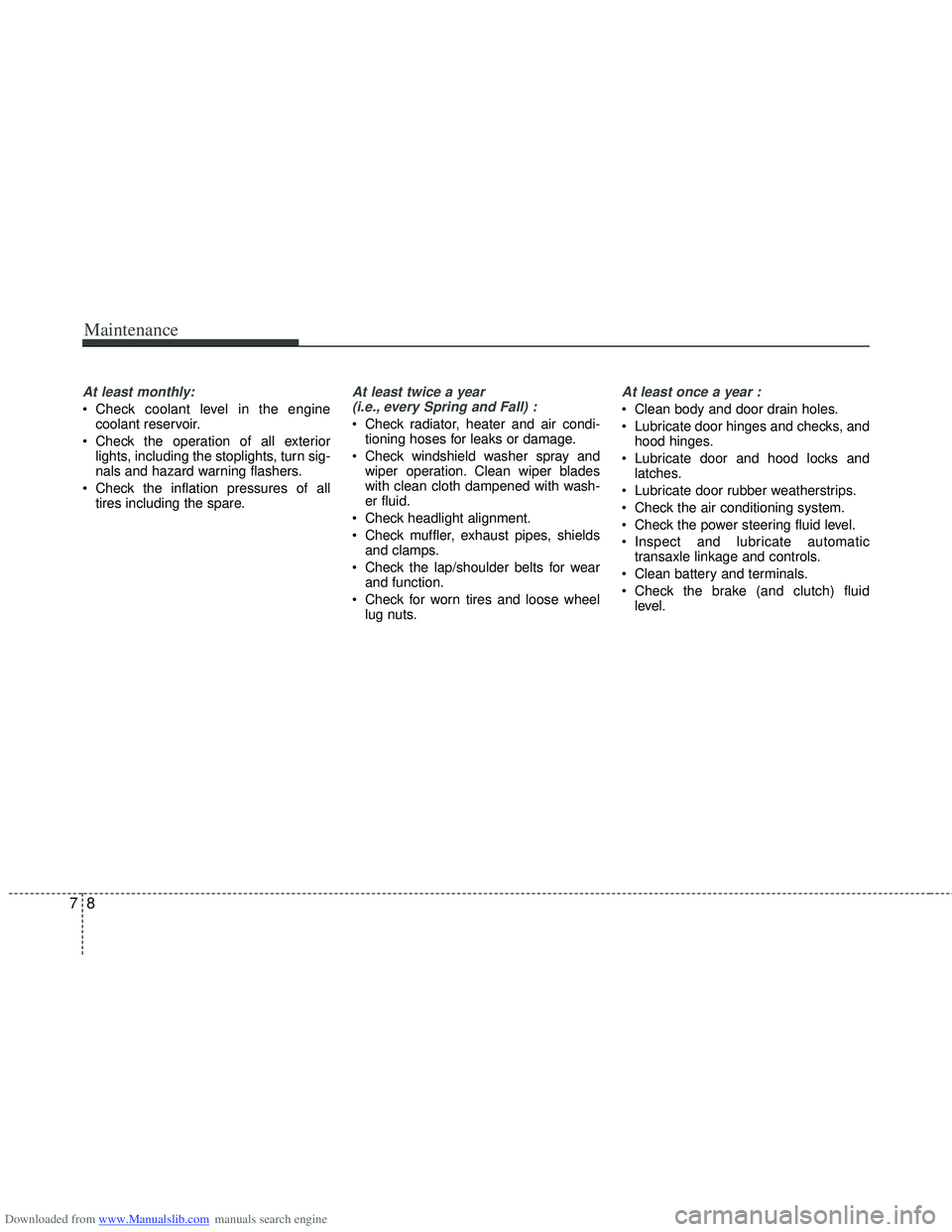
Downloaded from www.Manualslib.com manuals search engine Maintenance
87
At least monthly:
Check coolant level in the enginecoolant reservoir.
Check the operation of all exterior lights, including the stoplights, turn sig-
nals and hazard warning flashers.
Check the inflation pressures of all tires including the spare.
At least twice a year (i.e., every Spring and Fall) :
Check radiator, heater and air condi- tioning hoses for leaks or damage.
Check windshield washer spray and wiper operation. Clean wiper blades
with clean cloth dampened with wash-
er fluid.
Check headlight alignment.
Check muffler, exhaust pipes, shields and clamps.
Check the lap/shoulder belts for wear and function.
Check for worn tires and loose wheel lug nuts.
At least once a year :
Clean body and door drain holes.
Lubricate door hinges and checks, andhood hinges.
Lubricate door and hood locks and latches.
Lubricate door rubber weatherstrips.
Check the air conditioning system.
Check the power steering fluid level.
Inspect and lubricate automatic transaxle linkage and controls.
Clean battery and terminals.
Check the brake (and clutch) fluid level.
Page 469 of 534
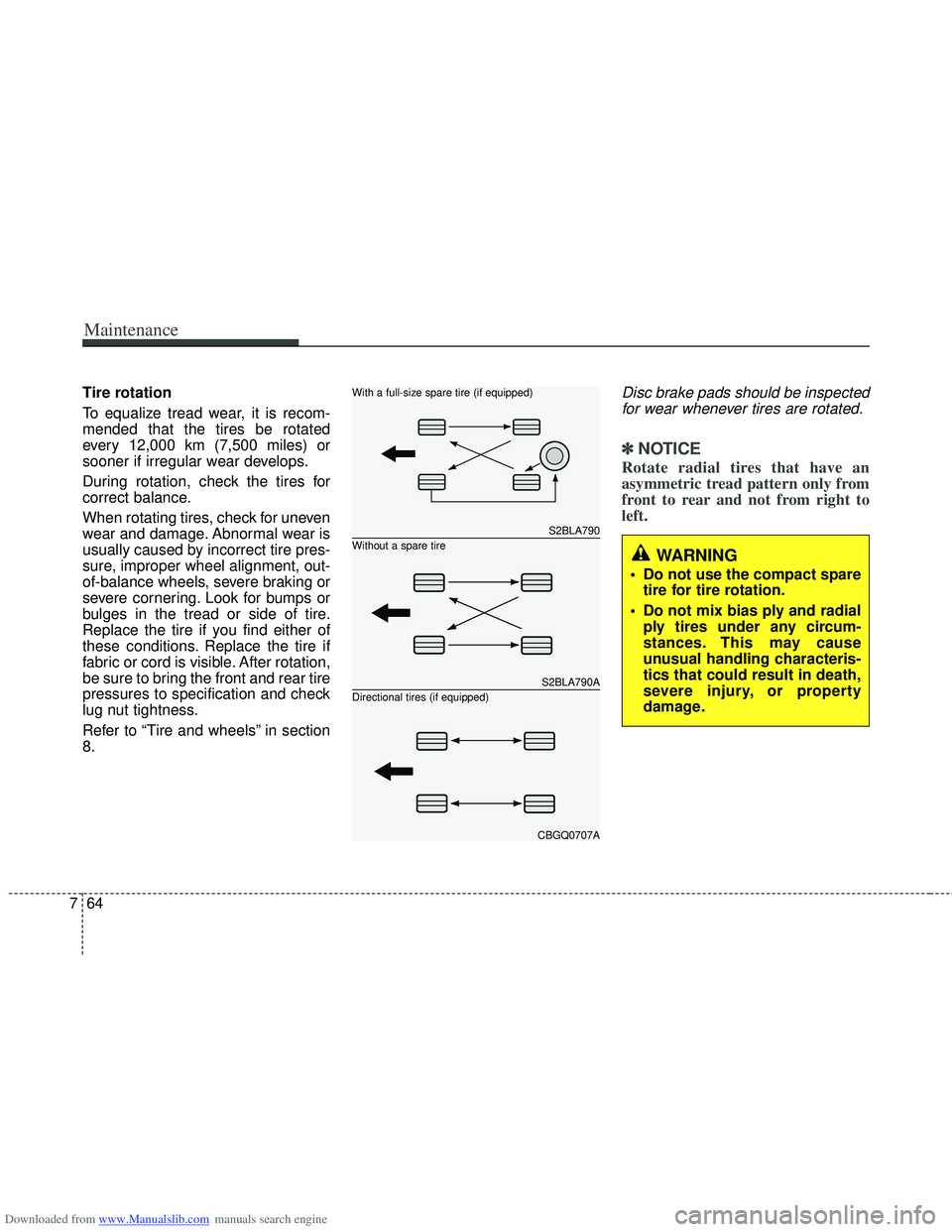
Downloaded from www.Manualslib.com manuals search engine Maintenance
64
7
Tire rotation
To equalize tread wear, it is recom-
mended that the tires be rotated
every 12,000 km (7,500 miles) or
sooner if irregular wear develops.
During rotation, check the tires for
correct balance.
When rotating tires, check for uneven
wear and damage. Abnormal wear is
usually caused by incorrect tire pres-
sure, improper wheel alignment, out-
of-balance wheels, severe braking or
severe cornering. Look for bumps or
bulges in the tread or side of tire.
Replace the tire if you find either of
these conditions. Replace the tire if
fabric or cord is visible. After rotation,
be sure to bring the front and rear tire
pressures to specification and check
lug nut tightness.
Refer to “Tire and wheels” in section
8.Disc brake pads should be inspected
for wear whenever tires are rotated.
✽ ✽ NOTICE
Rotate radial tires that have an
asymmetric tread pattern only from
front to rear and not from right to
left.
WARNING
Do not use the compact spare
tire for tire rotation.
Do not mix bias ply and radial ply tires under any circum-
stances. This may cause
unusual handling characteris-
tics that could result in death,
severe injury, or property
damage.
S2BLA790
S2BLA790A
CBGQ0707A
Without a spare tire With a full-size spare tire (if equipped)
Directional tires (if equipped)
Page 470 of 534
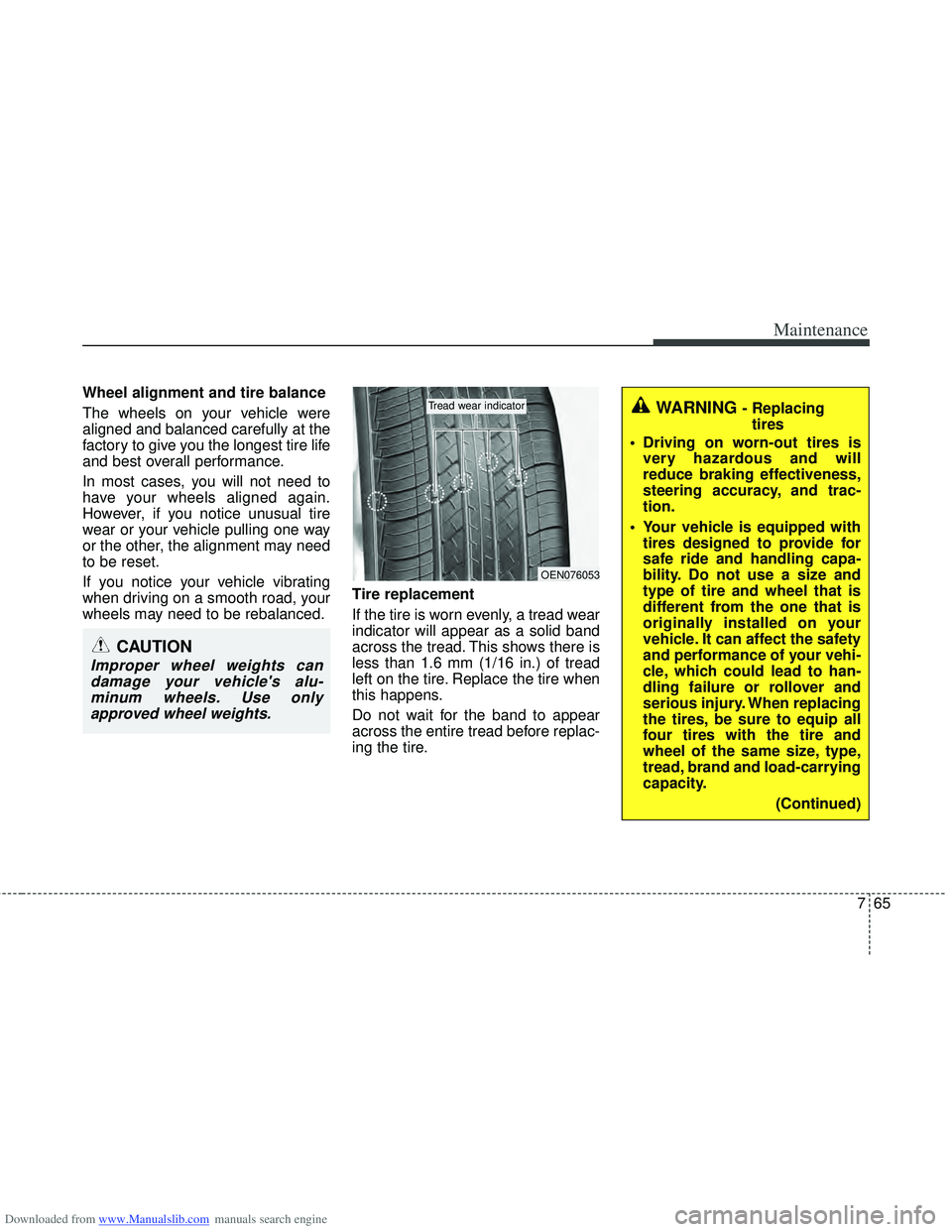
Downloaded from www.Manualslib.com manuals search engine 765
Maintenance
Wheel alignment and tire balance
The wheels on your vehicle were
aligned and balanced carefully at the
factory to give you the longest tire life
and best overall performance.
In most cases, you will not need to
have your wheels aligned again.
However, if you notice unusual tire
wear or your vehicle pulling one way
or the other, the alignment may need
to be reset.
If you notice your vehicle vibrating
when driving on a smooth road, your
wheels may need to be rebalanced.Tire replacement
If the tire is worn evenly, a tread wear
indicator will appear as a solid band
across the tread. This shows there is
less than 1.6 mm (1/16 in.) of tread
left on the tire. Replace the tire when
this happens.
Do not wait for the band to appear
across the entire tread before replac-
ing the tire.
CAUTION
Improper wheel weights can
damage your vehicle's alu-minum wheels. Use onlyapproved wheel weights.
WARNING - Replacing tires
Driving on worn-out tires is very hazardous and will
reduce braking effectiveness,
steering accuracy, and trac-
tion.
Your vehicle is equipped with tires designed to provide for
safe ride and handling capa-
bility. Do not use a size and
type of tire and wheel that is
different from the one that is
originally installed on your
vehicle. It can affect the safety
and performance of your vehi-
cle, which could lead to han-
dling failure or rollover and
serious injury. When replacing
the tires, be sure to equip all
four tires with the tire and
wheel of the same size, type,
tread, brand and load-carrying
capacity.
(Continued)
OEN076053
Tread wear indicator
Page 472 of 534
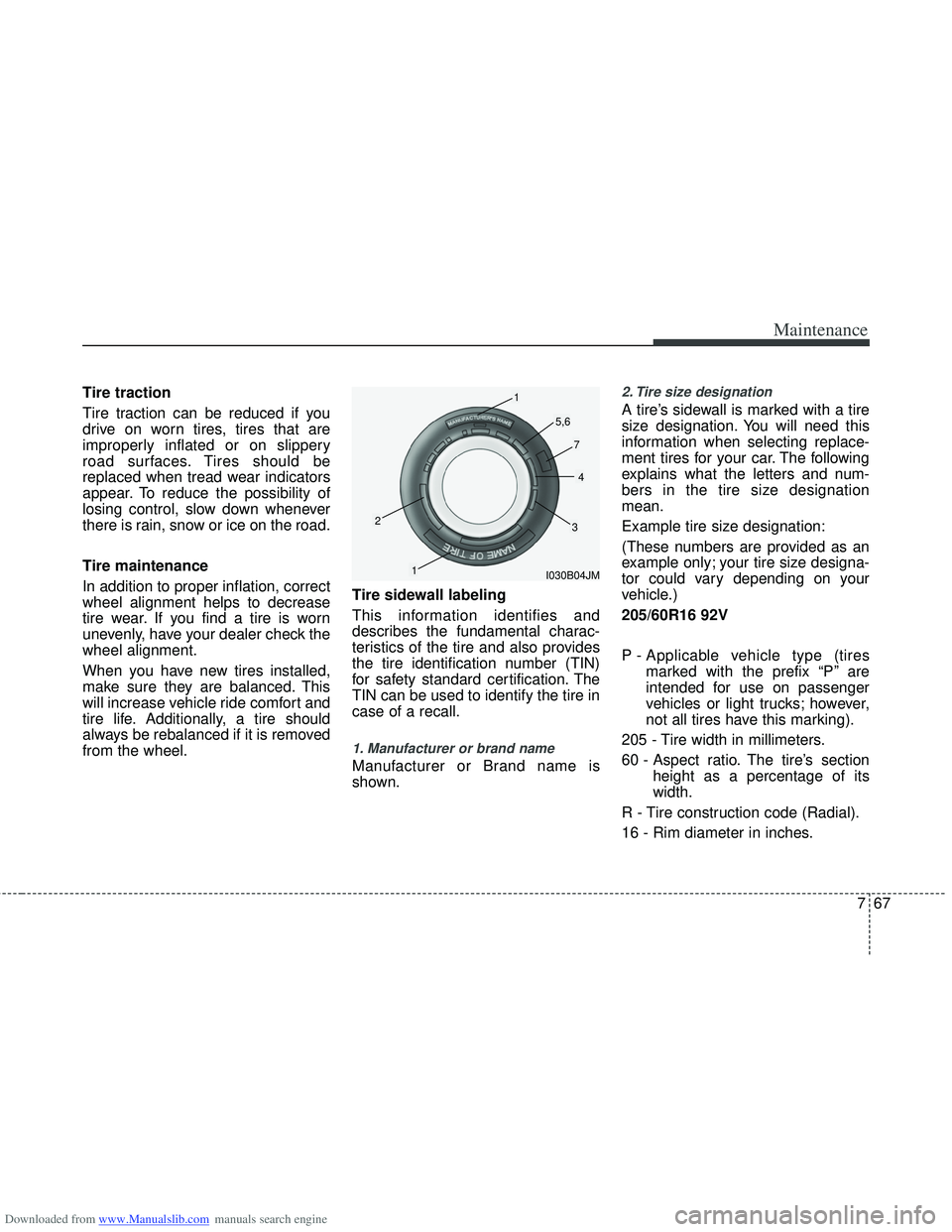
Downloaded from www.Manualslib.com manuals search engine 767
Maintenance
Tire traction
Tire traction can be reduced if you
drive on worn tires, tires that are
improperly inflated or on slippery
road surfaces. Tires should be
replaced when tread wear indicators
appear. To reduce the possibility of
losing control, slow down whenever
there is rain, snow or ice on the road.
Tire maintenance
In addition to proper inflation, correct
wheel alignment helps to decrease
tire wear. If you find a tire is worn
unevenly, have your dealer check the
wheel alignment.
When you have new tires installed,
make sure they are balanced. This
will increase vehicle ride comfort and
tire life. Additionally, a tire should
always be rebalanced if it is removed
from the wheel.Tire sidewall labeling
This information identifies and
describes the fundamental charac-
teristics of the tire and also provides
the tire identification number (TIN)
for safety standard certification. The
TIN can be used to identify the tire in
case of a recall.
1. Manufacturer or brand name
Manufacturer or Brand name is
shown.
2. Tire size designation
A tire’s sidewall is marked with a tire
size designation. You will need this
information when selecting replace-
ment tires for your car. The following
explains what the letters and num-
bers in the tire size designation
mean.
Example tire size designation:
(These numbers are provided as an
example only; your tire size designa-
tor could vary depending on your
vehicle.)
205/60R16 92V
P - Applicable vehicle type (tires
marked with the prefix “P’’ are
intended for use on passenger
vehicles or light trucks; however,
not all tires have this marking).
205 - Tire width in millimeters.
60 - Aspect ratio. The tire’s section height as a percentage of its
width.
R - Tire construction code (Radial).
16 - Rim diameter in inches.
I030B04JM
1
1
23
4
5,6
7
Page 533 of 534
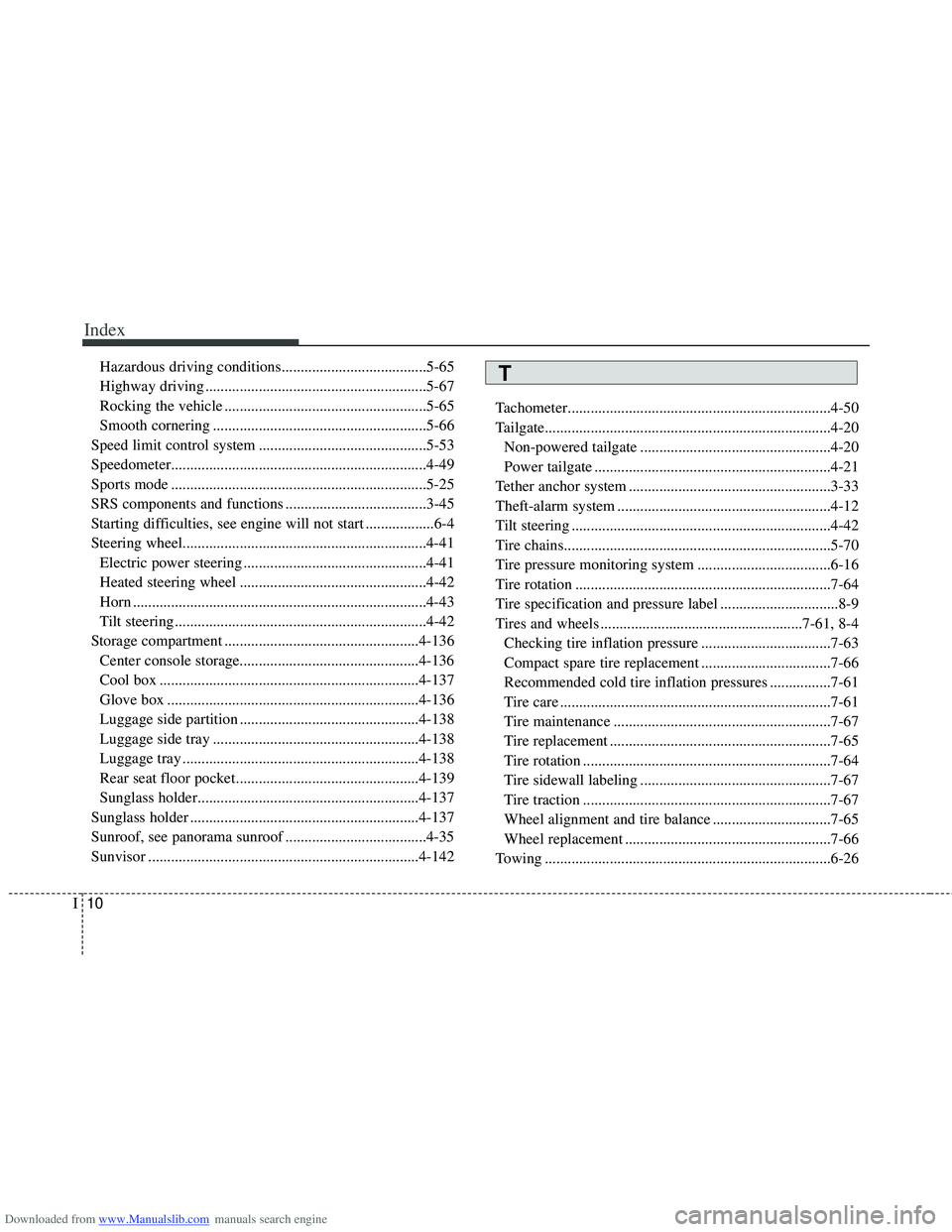
Downloaded from www.Manualslib.com manuals search engine Index
10I
Hazardous driving conditions......................................5-65
Highway driving ..........................................................5-67
Rocking the vehicle .....................................................5-65
Smooth cornering ........................................................5-66
Speed limit control system ............................................5-53
Speedometer...................................................................4-49
Sports mode ...................................................................5-25
SRS components and functions .....................................3-45
Starting difficulties, see engine will not start ..................6-4
Steering wheel...........................................................\
.....4-41 Electric power steering ................................................4-41
Heated steering wheel .................................................4-42
Horn ........................................................................\
.....4-43
Tilt steering ..................................................................4-42
Storage compartment ...................................................4-136 Center console storage...............................................4-1\
36
Cool box ....................................................................4-13\
7
Glove box ..................................................................4-136
Luggage side partition ...............................................4-138
Luggage side tray ......................................................4-138
Luggage tray ..............................................................4-138
Rear seat floor pocket................................................4-139
Sunglass holder..........................................................4-137
Sunglass holder ............................................................4-137
Sunroof, see panorama sunroof .....................................4-35
Sunvisor .......................................................................4\
-142 Tachometer.....................................................................4-5\
0
Tailgate........................................................................\
...4-20
Non-powered tailgate ..................................................4-20
Power tailgate ..............................................................4-21
Tether anchor system .....................................................3-33
Theft-alarm system ........................................................4-12
Tilt steering ....................................................................4-42\
Tire chains......................................................................5-\
70
Tire pressure monitoring system ...................................6-16
Tire rotation ...................................................................7-64
Tire specification and pressure label ...............................8-9
Tires and wheels .....................................................7-61, 8-4 Checking tire inflation pressure ..................................7-63
Compact spare tire replacement ..................................7-66
Recommended cold tire inflation pressures ................7-61
Tire care .......................................................................7\
-61
Tire maintenance .........................................................7-67
Tire replacement ..........................................................7-65
Tire rotation .................................................................7-64
Tire sidewall labeling ..................................................7-67
Tire traction .................................................................7-67
Wheel alignment and tire balance ...............................7-65
Wheel replacement ......................................................7-66
Towing ........................................................................\
...6-26T
Page 534 of 534
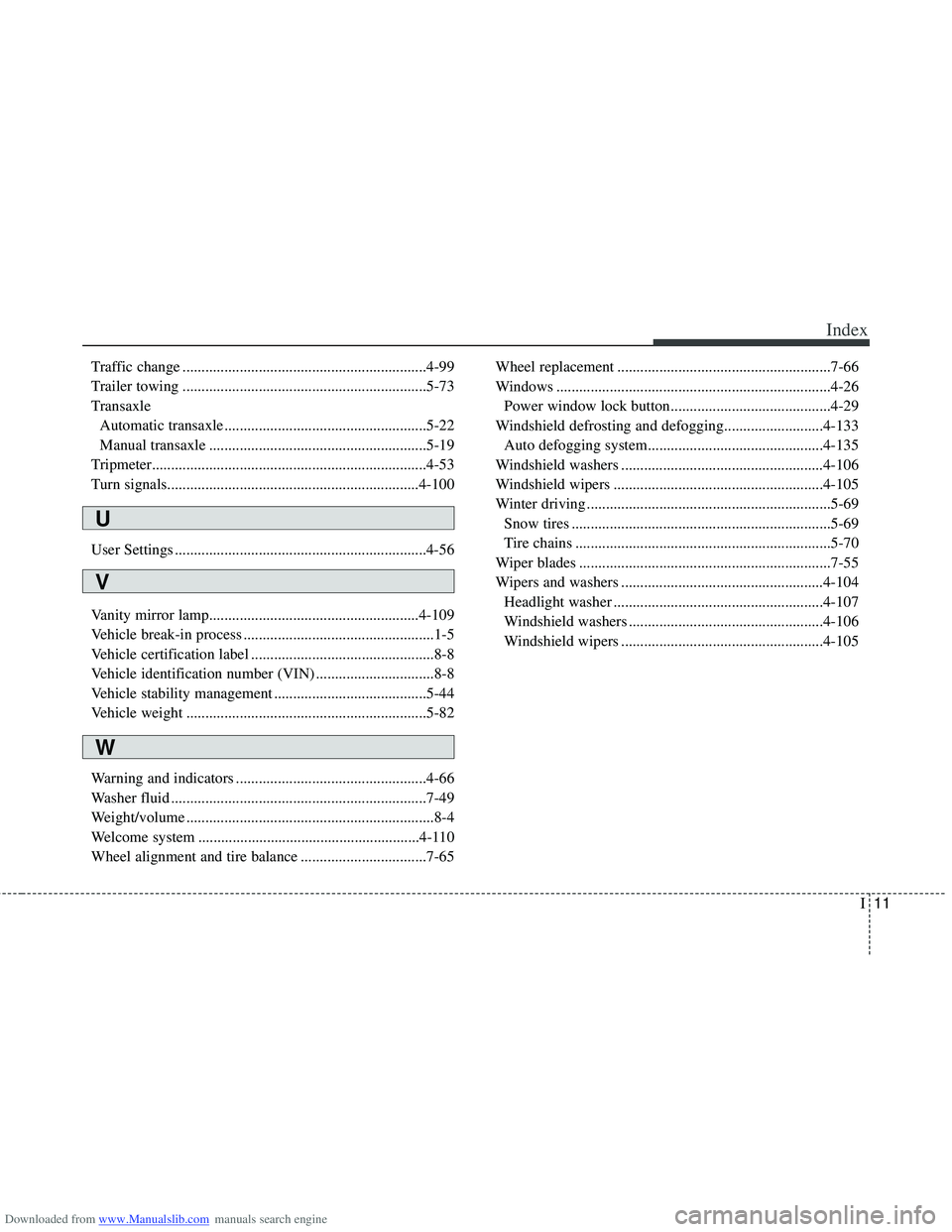
Downloaded from www.Manualslib.com manuals search engine I11
Index
Traffic change ................................................................4-99
Trailer towing ................................................................5-73
TransaxleAutomatic transaxle .....................................................5-22
Manual transaxle .........................................................5-19
Tripmeter........................................................................\
4-53
Turn signals..................................................................4-100
User Settings ..................................................................4-56
Vanity mirror lamp.......................................................4-109
Vehicle break-in process ..................................................1-5
Vehicle certification label ................................................8-8
Vehicle identification number (VIN) ...............................8-8
Vehicle stability management ........................................5-44
Vehicle weight ...............................................................5-82
Warning and indicators ..................................................4-66
Washer fluid ...................................................................7-49
Weight/volume .................................................................8-4
Welcome system ..........................................................4-110
Wheel alignment and tire balance .................................7-65 Wheel replacement ........................................................7-66
Windows ........................................................................\
4-26
Power window lock button..........................................4-29
Windshield defrosting and defogging..........................4-133 Auto defogging system..............................................4-135
Windshield washers .....................................................4-106
Windshield wipers .......................................................4-105
Winter driving ................................................................5-69 Snow tires ....................................................................5-69\
Tire chains ...................................................................5-70
Wiper blades ..................................................................7-55
Wipers and washers .....................................................4-104 Headlight washer .......................................................4-107
Windshield washers ...................................................4-106
Windshield wipers .....................................................4-105
U
V
W